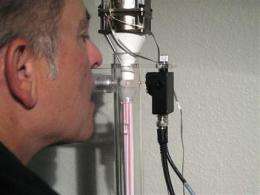Smoke on the water -- and in the microphone?

(AP) -- What do you get if you combine a smoke machine, some tubing, a laser pointer, a fan and a piece of toilet paper? Answer: a microphone unlike any other.
Inventor David Schwartz says the device, still a prototype, could be a big leap for microphones because it picks up sound almost out of thin air. It doesn't need a "diaphragm" - the thin membrane in a conventional microphone that responds to vibrations in the air.
The diaphragm can distort and weaken the sound picked up. Since it doesn't have one, the "smokrophone" could be a high-fidelity recording microphone, or a supersensitive long-range microphone for spying, Schwartz suggests.
Here's how the prototype works: A clear, vertical plastic tube has a small smoke machine at the bottom, and a fan at the top. The fan pulls the smoke in an even stream past a laser beam, which is pointed at a sensor. If you talk into a hole in the tube, you disturb the smoke stream, affecting how the sensor picks up the beam. Toilet paper over the hole keeps the puff of your breath from blowing away the smoke.
In the first demonstration outside Schwartz' workshop, the microphone could pick up his voice. It wasn't particularly clear, but then the setup is still crude: the laser is a $7 pointer, for instance.
Schwartz said he got the idea at an Italian restaurant in 2004, when he noticed that every time his wife spoke, the thin stream of smoke from a candle would waver. He soon bought a disco fog machine for experiments. In October, he will show off the microphone before the Audio Engineering Society in New York.
Schwartz has never designed a microphone before, though he does have a long history in audio engineering.
David Josephson of Josephson Engineering, who has made microphones for more than 20 years, is skeptical.
For one, the mechanical diaphragm in a conventional microphones isn't much of a limitation, he said. Other factors are more important, including the amount of noise introduced by the physics of the microphone itself. That's been a problem with another design for a diaphragm-less microphone, the "hot-wire anemometer."
Schwartz agrees noise levels are high now, but says they can be brought down.
Then there's the issue of keeping the smoke flowing. Ideally, Schwartz said, it would be closed-loop system that recycles water vapor. If not, the microphone could still work, but you could be singing "Smoke Gets In Your Eyes."
©2009 The Associated Press. All rights reserved. This material may not be published, broadcast, rewritten or redistributed.
















